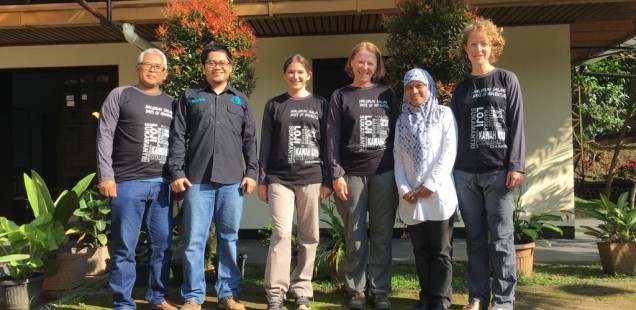
Field trip to Malaysia & Indonesia – Part 2
Part 2: Time for tea in Java
(This blog post forms part two of two pieces describing Jenny and Lydia’s recent trip to Malaysia and Indonesia, as a component of the 11 month NERC-funded Innovation Follow-on project: Decision support for restoring ecological networks in rapidly developing, biodiverse countries.)

The edge of the rainforest bordered by a tea plantation, within Mount Halimun Salak National Park, West Java, Indonesia.
We flew south over the forests, mountains and oil palm plantations of Borneo and landed in the recently modernised Soekarno-Hatta International Airport, retrieved Jane Hill and headed straight to Bogor, taking care to avoid Jakarta – the city of impenetrable traffic jams! We had the pleasure of staying a few minutes’ walk (and a treacherous road crossing) from Bogor’s Botanic Garden (Kebun Raya Bogor), an 87 hectare forested landscape in the middle of a city of one million residents, set up through a Dutch-British botanical collaboration in 1817. Definitely worth a visit!
The next morning we met with our main project partner for the Indonesian component of our project, Dr Lilik Budi Prasetyo, the Head of the Environmental Analysis & Spatial Modelling Lab. at Bogor Agricultural University (Institut Pertanian Bogor) and our other chief contacts, including Erlan Sodahlan, the Community Engagement Officer of Halimun Salak National Park. These two gentlemen guided us over the following three days, and were so patient in answering an almost continuous stream of questions from us interested and unacquainted British tourists!

Our party stopped to view the wildlife corridor we are proposing to model using Condatis, between Mount Halimun and Mount Salak, within the National Park.
After hearing about the exciting work that Lilik and his team are doing around improving the accuracy of remote classifying forest land cover in Indonesia, Jenny gave some background to Condatis and our collaborative project. Then it was time to head into the landscape in question: the Mount Halimun Salak National Park (Taman Nasional Gunung Halimun Salak, TNGHS).
We observed a complex, fascinating landscape as we drove through, with a mix of expertly terraced rice paddy, small vegetable plots, perched hamlets on the edges of small, steep valleys, all with the backdrop of Mounts Halimun and Salak. Beautiful and interesting to look at, but far from a natural environment with only small patches of forest remaining outside of the Park. Much like all of the UK! Inside the Core Zone, there remains one of the largest continuous tracts of tropical forest in Java, and it is intact due to strict protection. Outside of this zone, there is a complex mosaic of human-modified landscapes, with degraded forest in between tea plantations, hydrothermal electricity plants and football pitches. Erlan and the National Park staff talked to us about how they are working with individual communities to develop village-specific Memorandums of Understanding on responsible use strategies and to make decisions on where to establish collaborative forest restoration projects.

The Indonesia Condatis team outside the Taman Nasional Gunung Halimun Salak (TNGHS) Offices: Lilik, Erlan, Jenny, Jane, Pairah and Lydia.
During our stay at the TNGHS Headquarters, we carried out a one-day workshop on Condatis for ten staff members of the National Park. The morning was spent introducing participants to Condatis and allowing everyone to have a go at their own analyses; the afternoon involved a discussion around the case study we are performing in their landscape. Through some lively discussions (mostly in Bahasa Indonesia!) we gathered useful feedback on the key species of interest and major conservation challenges. We are hopeful that Condatis will generate maps which will highlight priority areas for forest restoration in and around TNGHS’s corridors. We had a fascinating few days learning about another tropical forested landscape, which shares broad similarities with Sabah and important subtle differences.
Three action-packed weeks later we returned to the UK, bringing the tropical temperatures with us it seemed! Now it’s time to process all of the information we observed on our travels across the islands of Borneo and Java and to develop our plan of work. We thank everyone who made our trip so exciting, so interesting and fed us such yummy food!
For the first episode in our Southeast Asian adventures, click here.

